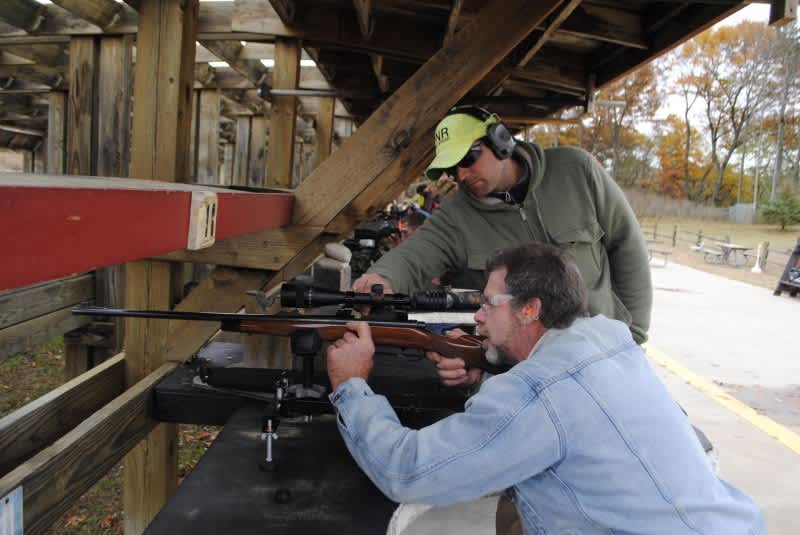Setting Your Sights on Michigan Firearms Deer Season
Bob Gwizdz 11.06.13

Checked the calendar lately? Firearms deer season—probably the single biggest day in Michigan outdoors—is bearing down on us like a runaway train. And while it may be a little late in the game to start making all new plans for the November 15 opener, there’s still plenty of time to do the one thing that will most guarantee your success: shoot your firearm.
Face it; you’re only going to get so many chances to shoot a deer. Do you want to miss when you do?
I didn’t think so.
Generally speaking, you can send one round down range and tell whether your gun is shooting where you aim. And, fact is, unless your scope is way out of whack, one bullet is really all you need to make sure you are on target.
Virtually all public shooting ranges will be open daylight to dark this week for hunters who have neglected to get the job done. And most private shooting clubs have sighting-in days when the public is invited to use the range for a modest fee.
Over the years, I’ve been to a number of shooting facilities and talked with plenty of veteran shooters, many of whom have their own theories and how to best sight in a firearm. Personally, I’ve gone to the two-man, one-shot method (and you can do this by yourself if you have a gun vise, but for the sake of argument, let’s assume you don’t).
Using sandbags to secure your firearm, aim at the target and squeeze the trigger. Now, aim at the same place, but have your buddy walk the crosshairs of your scope to where the bullet hit. Voila. You are now sighted in.
This is not easily done at 100 yards with a rifle—unless your eyesight is much better than mine—but fairly easily accomplished at 50 yards. Generally speaking, if you are dead-on at 50 yards with a high-velocity rifle you’re going to be about three inches high at 100 yards, which is where I personally like to sight my rifle. That puts me pretty much on at around 250 and makes it possible for me to shoot with confidence at 300 (and 50) yards.
The rule of thumb for most centerfire rifles is: on at 50, on at 250 (shotgun and muzzleloader ballistics are not quite so simple). That will take care of most shooting opportunities in Michigan.

Most Michigan deer hunters will rarely shoot at targets more than 100 yards away. I read somewhere once that the average Michigan firearm-taken deer is killed at 60 yards, but I haven’t been able to find that information since.
But there’s an old agricultural field where I hunt where I can see a quarter mile and I like the idea of being able to reach out, should I see one that’s worthy at that range.
Truth is, I haven’t touched my scope in years. I haven’t had to. This year, I shot my rifle twice—I felt like I jerked a little bit on the first shot, so I sent a second downrange. When I walked down to look at my target, I was off by one inch with one shot (the one I jerked?) and a quarter inch with the other. No need for fine-tuning.
I visited briefly with Alex Koptyev, the safety officer at the Department of Natural Resources shooting range at Rose Lake Wildlife Area, when I was shooting. Koptyev said the staff at the range is more than happy to help shooters, many of whom are lost.
“A lot of people lack a basic understanding of firearms,” Koptyev relayed.
The biggest problem Koptyev said he sees is a loose, poorly mounted, or malfunctioning scope. And virtually everyone is using a scope these days.
“Most rifles coming out of the factory don’t even have iron sights anymore,” he said.
Anymore? I bought my Ruger M77 in 1982 and it didn’t have sights on it then.
But the next biggest problem is people misunderstanding how to adjust their sights.
“They’re trying to bring the scope to the bull’s-eye rather than bringing it to the point of impact,” Koptyev said.
I’ll attest to that. Several years back I was at the range when the fellow next to me, who had been shooting well to the right of the bull’s-eye, moved his sights to the left. The next three rounds he fired weren’t even on paper.
When that happens, you’ve got problems. Fortunately, most range officers have bore-sighting devices that can get you back in the game. Otherwise, you’ll have to go to the 25-yard range and start there.
One other note: I had a range officer tell me once that after he shoots his gun in, he never takes it indoors again until after the season. He puts it in a hard case and leaves it in the truck. Changes in temperature and humidity can cause wooden stocks to swell and change where the gun shoots. That may be putting a rather fine point on things, but my rifle’s in my truck.
Why take a chance, eh?
For more information on Michigan hunting go to michigan.org. Click here to purchase a Michigan hunting license online.

